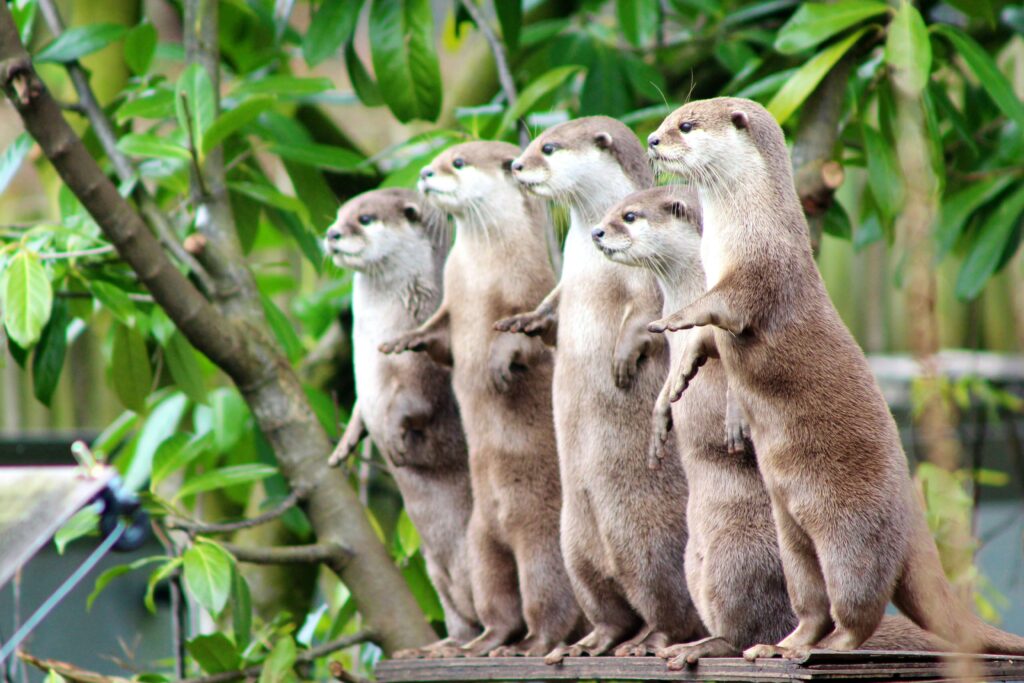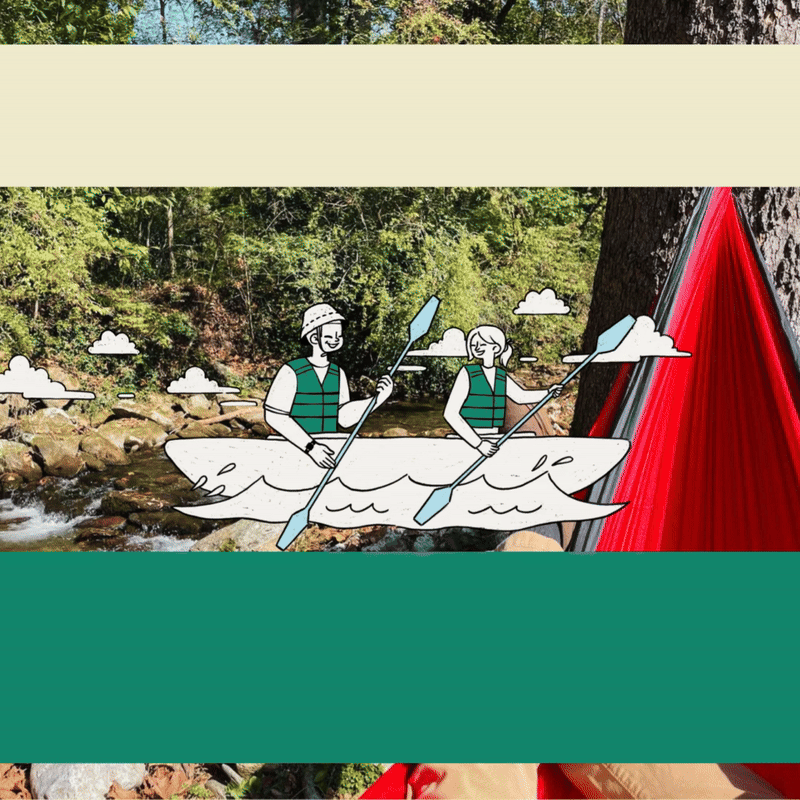Among all the wildlife encounters possible during Nantahala white water rafting adventures, few are as delightful and rare as spotting a North American river otter. These sleek, playful mammals embody the wild spirit of the Nantahala River, darting through the same rapids that challenge rafters while displaying an aquatic grace that makes every Nantahala white water rafting guide hope their groups will be lucky enough to witness these remarkable predators in action.
River otters represent one of the great conservation success stories in Western North Carolina. Once nearly eliminated from the region due to habitat loss and pollution, these charismatic carnivores have made a remarkable comeback along waterways like the Nantahala, adding an extra element of excitement to every Nantahala white water rafting trip.
The Return of the River Otter to Nantahala Waters
The story of river otters along the Nantahala River mirrors broader conservation efforts throughout Appalachia. By the 1970s, river otters had virtually disappeared from North Carolina’s mountain streams, victims of habitat destruction, water pollution, and unregulated trapping.
Today’s Nantahala white water rafting participants benefit from decades of restoration work that brought otters back to these pristine mountain waters. Reintroduction programs beginning in the 1990s, combined with improved water quality and habitat protection, have restored healthy otter populations throughout the Nantahala River system.
The clean, cold waters that make Nantahala white water rafting so refreshing also provide ideal conditions for river otters. Fed by deep releases from Nantahala Lake, the river maintains the high water quality and abundant fish populations that otters require to thrive.

Identifying River Otters During Nantahala White Water Rafting
River otters can be challenging to spot during Nantahala white water rafting trips, but knowing what to look for increases your chances of witnessing these elusive predators. Adult otters measure 3-4 feet in length with thick, chocolate-brown fur that appears almost black when wet.
Swimming behavior provides the most reliable identification clue. Unlike beavers, which swim with their heads and backs visible, otters dive frequently and can remain submerged for up to four minutes. During Nantahala white water rafting trips, otters often appear as sleek heads popping up unexpectedly from the water before disappearing again.
Playful activities distinguish otters from other aquatic wildlife visible during Nantahala white water rafting adventures. Otters frequently engage in apparent play behavior, including sliding down muddy banks, wrestling with each other, and performing barrel rolls in the water.
Group dynamics also help with identification. River otters are social animals that often travel in family groups called rafts (coincidentally sharing a name with your Nantahala white water rafting vessel). Seeing multiple sleek forms diving and surfacing together almost certainly indicates otters rather than other wildlife.
Habitat and Behavior Along the Nantahala River
The Nantahala River provides ideal habitat for river otters, combining clean water, abundant prey, and suitable denning sites along its forested banks. Understanding otter habitat preferences helps Nantahala white water rafting participants know where to watch for these elusive mammals.
Denning sites along the river include hollow logs, abandoned beaver lodges, and burrows in riverbanks. Otters often establish multiple dens throughout their territory, using different sites for raising young, resting, and escaping predators. These dens are typically located in the quieter stretches between rapids that Nantahala white water rafting groups navigate.
Feeding territories encompass the entire river system, with individual otters or family groups claiming stretches several miles long. The diverse fish population in Nantahala waters, including trout, bass, and various minnow species, provides abundant prey for these skilled hunters.
Travel corridors follow the river course and extend into tributary streams. Otters may travel several miles daily while hunting, using the same water routes that Nantahala white water rafting adventures follow from put-in to take-out.
The Otter’s Role as Aquatic Predator
River otters serve as apex aquatic predators in the Nantahala River ecosystem, helping maintain the healthy fish populations that make this waterway exceptional for both wildlife and Nantahala white water rafting experiences.
Hunting techniques showcase otters’ remarkable aquatic adaptations. These mammals can dive to depths of 60 feet and remain underwater for extended periods while pursuing fish. Their streamlined bodies, webbed feet, and sensitive whiskers make them incredibly efficient hunters in the turbulent waters that challenge Nantahala white water rafting participants.
Prey diversity includes fish, crayfish, frogs, and aquatic invertebrates. Otters consume approximately 15-25% of their body weight daily, requiring constant hunting activity that makes them more likely to be spotted during Nantahala white water rafting trips.
Ecological impact extends beyond simple predation. By controlling fish populations and prey species distribution, otters help maintain the aquatic ecosystem balance that supports the diverse wildlife community visible during Nantahala white water rafting adventures.
When and Where to Spot Otters During Nantahala White Water Rafting
Otter encounters during Nantahala white water rafting trips follow predictable patterns based on these animals’ behavior and habitat preferences. Understanding these patterns helps rafters maximize their chances of witnessing these playful predators.
Early morning trips provide the best opportunities for otter sightings. These predominantly crepuscular animals are most active during dawn and dusk hours, making sunrise Nantahala white water rafting adventures ideal for wildlife viewing.
Quiet water sections between major rapids offer the highest probability of otter encounters. While otters can navigate whitewater, they prefer calmer areas for hunting and socializing. The pools between rapids during Nantahala white water rafting trips provide perfect otter habitat.
Seasonal variations affect otter visibility throughout the Nantahala white water rafting season. Spring brings increased activity as otters breed and establish territories, while fall sees families traveling together before young otters disperse to establish their own territories.
Weather influences also impact otter behavior. Overcast days often increase otter activity, as these animals avoid bright sunlight when possible. Light rain can actually improve otter spotting chances during Nantahala white water rafting trips.
Otter Family Life and Social Behavior
River otters display complex social behaviors that make encounters during Nantahala white water rafting trips particularly entertaining for wildlife watchers. Understanding otter family dynamics enhances appreciation for these remarkable mammals.
Breeding and denning occur in late winter and early spring, with females giving birth to 2-4 kits after a gestation period of approximately two months. During Nantahala white water rafting season, rafters might encounter family groups with young otters learning essential swimming and hunting skills.
Kit development follows a fascinating progression. Young otters are born blind and helpless but develop quickly under their mother’s care. By the time Nantahala white water rafting season begins, kits are usually ready to accompany their mothers on hunting expeditions.
Play behavior serves important developmental functions while providing entertainment for lucky Nantahala white water rafting observers. Otters engage in elaborate games that help young animals develop hunting skills, social bonds, and physical coordination.
Communication methods include a variety of vocalizations, scent marking, and physical gestures. Rafters during Nantahala white water rafting trips might hear otter chirps, whistles, and chatter as family groups communicate while foraging.
Conservation Success and Ongoing Challenges
The presence of river otters during Nantahala white water rafting adventures represents a remarkable conservation achievement, but these animals still face challenges that require ongoing protection efforts.
Population recovery has exceeded most biologists’ expectations, with otter numbers throughout Western North Carolina now considered stable and slowly increasing. This success story enhances the wilderness experience that defines Nantahala white water rafting adventures.
Habitat protection remains crucial for maintaining viable otter populations. The pristine watershed conditions that make Nantahala white water rafting possible also provide essential otter habitat requiring continued conservation efforts.
Water quality maintenance directly impacts otter populations, as these predators serve as indicators of aquatic ecosystem health. The clean waters that attract Nantahala white water rafting enthusiasts also support the diverse prey base that otters require.
Human interactions generally remain minimal and positive along the Nantahala River, thanks to responsible Nantahala white water rafting practices and public education efforts that promote wildlife respect and habitat protection.
Photography and Documentation Opportunities
River otter encounters during Nantahala white water rafting create exceptional photography opportunities for wildlife enthusiasts, though their elusive nature requires patience and preparation.
Equipment considerations for otter photography include waterproof cameras and telephoto capabilities. The quick, unpredictable movements of otters challenge photographers, but the playful behaviors create unique image opportunities during Nantahala white water rafting trips.
Timing techniques focus on anticipating otter behavior patterns. These animals often surface in predictable locations when hunting, allowing experienced wildlife watchers to position themselves for better viewing during Nantahala white water rafting adventures.
Ethical guidelines emphasize maintaining appropriate distances and avoiding behaviors that might disturb otter families. Responsible wildlife photography enhances rather than detracts from the natural experience that defines quality Nantahala white water rafting trips.
The Broader Ecosystem Connection
River otters serve as keystone species in the Nantahala River ecosystem, with their presence indicating the healthy aquatic environment that makes Nantahala white water rafting such an exceptional wilderness experience.
Indicator species status means otter populations reflect overall watershed health. The thriving otter community along the Nantahala River demonstrates the pristine conditions that attract both wildlife and Nantahala white water rafting enthusiasts.
Food web connections link otters to every aspect of the aquatic ecosystem, from microscopic organisms to large fish species. This complex web of relationships creates the diverse wildlife community that enriches every Nantahala white water rafting adventure.
Habitat interdependence connects terrestrial and aquatic environments throughout the watershed. The forested banks that provide scenic beauty during Nantahala white water rafting trips also supply essential denning sites and travel corridors for otter families.
Enhancing Your Otter Spotting Experience
Maximizing your chances of otter encounters during Nantahala white water rafting requires understanding these animals’ behavior patterns and habitat preferences.
Observation techniques include scanning quiet pools carefully and watching for subtle surface disturbances that might indicate diving otters. Experienced Nantahala white water rafting guides know the most productive otter-watching locations along their regular routes.
Patience requirements cannot be overstated when seeking otter encounters. These animals appear and disappear quickly, requiring constant vigilance from Nantahala white water rafting participants hoping to spot them.
Group coordination helps multiply observation opportunities, as multiple sets of eyes increase the chances of detecting otters during Nantahala white water rafting trips. Guides often position rafts strategically to optimize wildlife viewing opportunities.
Supporting Otter Conservation Through Responsible Recreation
Nantahala white water rafting participants can contribute to otter conservation through responsible recreation practices and supporting organizations working to protect river ecosystems.
Leave No Trace principles practiced during river trips help maintain the pristine conditions that support healthy otter populations. Proper waste disposal and minimal impact camping prevent habitat degradation that could affect these sensitive predators.
Supporting conservation organizations working in the Nantahala region helps fund research and habitat protection efforts that benefit otters and other wildlife. Many Nantahala white water rafting outfitters partner with conservation groups to promote environmental awareness.
Educational advocacy spreads awareness about otter conservation needs and success stories. Sharing positive otter encounters from Nantahala white water rafting trips helps build public support for continued habitat protection and restoration efforts.
The Magic of Otter Encounters
Spotting a river otter during your Nantahala white water rafting adventure represents one of the most special wildlife encounters possible in North Carolina’s mountains. These playful predators embody the wild spirit that makes the Nantahala River such an exceptional destination for outdoor enthusiasts.
Whether you glimpse an otter family playing in a quiet pool, watch a solitary hunter diving for fish, or simply know that these remarkable mammals inhabit the waters around you, their presence adds an element of authentic wilderness magic to every Nantahala white water rafting experience.
The return of river otters to Nantahala waters demonstrates what’s possible when conservation efforts combine with habitat protection and public support. Every Nantahala white water rafting trip through otter habitat celebrates this conservation success while supporting the ongoing efforts needed to ensure these playful predators continue thriving in North Carolina’s mountain streams for generations to come.
